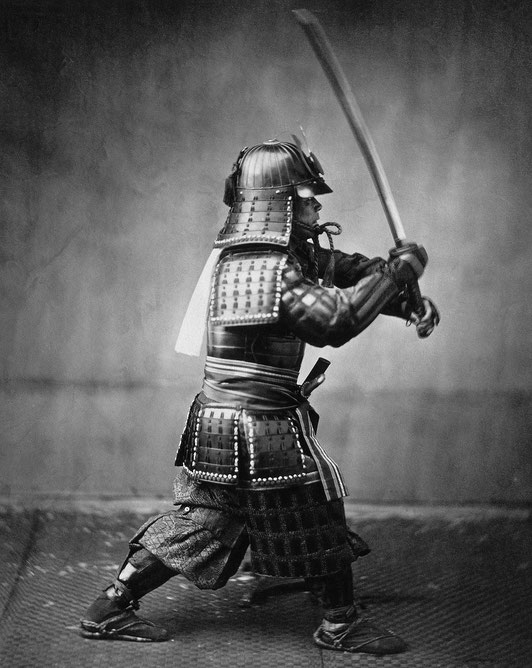The historical evolution of the Samurai, Japan's elite warriors

For centuries, an elite class of fighters ruled over feudal Japan. Emerging from the chaos of clan wars in the Heian Period, the samurai became the backbone of Japan's military power.
By the time the shoguns ruled, the samurai stood at the very centre of Japanese society. Yet, the story of the samurai is also about the rise of a class whose influence extended into every aspect of life, from politics to culture, before meeting a sudden and dramatic end.
Who were the samurai?
The samurai constituted one of the four social classes within Japanese society.
They were expertly trained warriors, adept in wielding both bows and swords.
During the feudal era, samurai were a crucial component of Japanese military forces.
The samurai first appeared in the late 8th or 9th centuries AD in the Heian Period.
A new system of military service had created private armies who were paid for by local warlords, known as daimyo.
The original meaning of the word ‘samurai’ came from the verb saburau, which meant ‘to serve’.
Theoretically, the samurai existed to serve the Japanese emperor. However, in reality, they served an individual daimyo who was willing to pay for their help.

Service to the daimyo
While the daimyo governed Japan's lands, their power depended on the samurai they commanded.
Samurai swore oaths of loyalty to their daimyo and protected his lands from robbers and rebels in his absence.
Most importantly, they battled on behalf of the daimyo during conflicts. Samurai, therefore, needed to be ready to fight at a moment’s notice.
Samurai were often housed in their lord's castle or in their own residences, not typically in specialized military barracks.
The more rich and powerful a daimyo became, the more samurai he could pay for.
Ultimately, the most successful daimyo even used their samurai armies to seize control of Japan from the emperor himself.
The Japanese emperor was forced to create a new military position to recognise the most powerful daimyo: the shogun.
Bushido code
Samurai warriors were meant to follow a strict code of behaviour known as the bushido code.
This code centred around the concepts of honesty and loyalty.
A samurai’s first responsibility was to faithfully serve his daimyo. This meant that they should be willing to die, if necessary, to do so.
Dying for one's daimyo in battle was common, yet samurai were also expected to engage in duels should the honor of their lord be challenged.
Under bushido, a samurai was required to learn seven martial arts: archery (kyujutsu), swordsmanship (kenjutsu), the spear, fencing, horse riding, military strategy, and techniques of jujutsu.
During the Edo Period of Japanese period (1603-1868) different ranks of samurai warriors were developed:
- Gokenin: this was the lowest rank
- Goshi: this rank worked as farmers as well, but had to give up some of their special privileges
- Hatamoto: this was the highest rank
Training
Since ‘samurai’ was a social class, not a career, children were born as samurai. Young boys of this class began military training from an early age.
They were given lessons in how to use bows, ride horses, wrestle, and fight with the samurai sword (katana).
Many daimyo set up specialised schools for these lessons. Surprisingly, samurai warriors were also taught sophisticated reading and writing, particularly poetry.
But they were also expected to know a broad range of literature, including Confucian texts, military strategies, and history.
There was an expectation that samurai were not only warriors, but also refined members of the nobility.
Ronin
Since samurai culture was so heavily invested in the idea of loyalty to a daimyo lord, what happened if a daimyo died?
Some samurai would leave to find a new lord to serve. However, others took the opportunity to wander freely.
Samurai who had no master were called ronin. There was no set rule for what a ronin should do, because he was his own master.
Many ronin became ‘swords for hire’ and would fight for any daimyo who was willing to pay.
Other ronin became nothing more than robbers and thieves, using their military skills to intimidate peasants.
The fall of the samurai
During the two centuries of peace under the Tokugawa shogunate, the demand for trained warriors diminished.
Consequently, many samurai families shifted their focus to administrative roles in government or to managing businesses.
By the mid-19th century, with the introduction of gunpowder weapons by Western nations to Japan, the samurai class became obsolete.
During the Meiji Period, the samurai class was disbanded forever. In fact, Saigō Takamori is often considered the 'last true samurai'.
He led the Satsuma Rebellion in 1877 in a final, failed attempt to preserve the samurai's influence in the face of modernization.
However, he failed, and it brought an end to the age of the samurai.
What do you need help with?
Download ready-to-use digital learning resources
Copyright © History Skills 2014-2025.
Contact via email
With the exception of links to external sites, some historical sources and extracts from specific publications, all content on this website is copyrighted by History Skills. This content may not be copied, republished or redistributed without written permission from the website creator. Please use the Contact page to obtain relevant permission.





